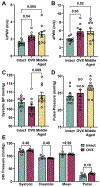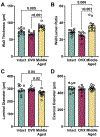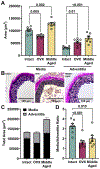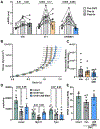Ovariectomy-Induced Arterial Stiffening Differs From Vascular Aging and Is Reversed by GPER Activation
- PMID: 38445498
- PMCID: PMC11023783
- DOI: 10.1161/HYPERTENSIONAHA.123.22024
Ovariectomy-Induced Arterial Stiffening Differs From Vascular Aging and Is Reversed by GPER Activation
Abstract
Background: Arterial stiffness is a cardiovascular risk factor and dramatically increases as women transition through menopause. The current study assessed whether a mouse model of menopause increases arterial stiffness in a similar manner to aging and whether activation of the G-protein-coupled estrogen receptor could reverse stiffness.
Methods: Female C57Bl/6J mice were ovariectomized at 10 weeks of age or aged to 52 weeks, and some mice were treated with G-protein-coupled estrogen receptor agonists.
Results: Ovariectomy and aging increased pulse wave velocity to a similar extent independent of changes in blood pressure. Aging increased carotid wall thickness, while ovariectomy increased material stiffness without altering vascular geometry. RNA-sequencing analysis revealed that ovariectomy downregulated smooth muscle contractile genes. The enantiomerically pure G-protein-coupled estrogen receptor agonist, LNS8801, reversed stiffness in ovariectomy mice to a greater degree than the racemic agonist G-1. In summary, ovariectomy and aging induced arterial stiffening via potentially different mechanisms. Aging was associated with inward remodeling, while ovariectomy-induced material stiffness independent of geometry and a loss of the contractile phenotype.
Conclusions: This study enhances our understanding of the impact of estrogen loss on vascular health in a murine model and warrants further studies to examine the ability of LNS8801 to improve vascular health in menopausal women.
Keywords: aging; estrogens; menopause; mice; vascular stiffness.
Conflict of interest statement
Figures






Update of
-
Ovariectomy-Induced Arterial Stiffening Differs from Vascular Aging and is Reversed by GPER Activation.bioRxiv [Preprint]. 2023 Aug 14:2023.08.10.552881. doi: 10.1101/2023.08.10.552881. bioRxiv. 2023. Update in: Hypertension. 2024 May;81(5):e51-e62. doi: 10.1161/HYPERTENSIONAHA.123.22024. PMID: 37645992 Free PMC article. Updated. Preprint.
Similar articles
-
Ovariectomy-Induced Arterial Stiffening Differs from Vascular Aging and is Reversed by GPER Activation.bioRxiv [Preprint]. 2023 Aug 14:2023.08.10.552881. doi: 10.1101/2023.08.10.552881. bioRxiv. 2023. Update in: Hypertension. 2024 May;81(5):e51-e62. doi: 10.1161/HYPERTENSIONAHA.123.22024. PMID: 37645992 Free PMC article. Updated. Preprint.
-
Dihydrotestosterone induces arterial stiffening in female mice.Biol Sex Differ. 2024 Jan 23;15(1):9. doi: 10.1186/s13293-024-00586-3. Biol Sex Differ. 2024. PMID: 38263051 Free PMC article.
-
Sex differences in vascular aging and impact of GPER deletion.Am J Physiol Heart Circ Physiol. 2022 Aug 1;323(2):H336-H349. doi: 10.1152/ajpheart.00238.2022. Epub 2022 Jun 24. Am J Physiol Heart Circ Physiol. 2022. PMID: 35749718 Free PMC article.
-
New insights into arterial stiffening: does sex matter?Am J Physiol Heart Circ Physiol. 2018 Nov 1;315(5):H1073-H1087. doi: 10.1152/ajpheart.00132.2018. Epub 2018 Jul 20. Am J Physiol Heart Circ Physiol. 2018. PMID: 30028199 Free PMC article. Review.
-
Between Rho(k) and a hard place: the relation between vessel wall stiffness, endothelial contractility, and cardiovascular disease.Circ Res. 2015 Feb 27;116(5):895-908. doi: 10.1161/CIRCRESAHA.116.305720. Circ Res. 2015. PMID: 25722443 Review.
Cited by
-
Prognostic factors of MINOCA and their possible mechanisms.Prev Med Rep. 2024 Feb 4;39:102643. doi: 10.1016/j.pmedr.2024.102643. eCollection 2024 Mar. Prev Med Rep. 2024. PMID: 38426041 Free PMC article. Review.
-
Roadmap for alleviating the manifestations of ageing in the cardiovascular system.Nat Rev Cardiol. 2025 Aug;22(8):577-605. doi: 10.1038/s41569-025-01130-5. Epub 2025 Feb 19. Nat Rev Cardiol. 2025. PMID: 39972009 Review.
-
Expression and Hormonal Regulation of Entpd3 at Various Estrous Cycle Stages in the Mouse Uterus.Reprod Sci. 2025 Apr;32(4):1033-1041. doi: 10.1007/s43032-024-01750-1. Epub 2024 Nov 20. Reprod Sci. 2025. PMID: 39567465
-
Association Between Mediterranean Diet and Other Healthy Habits and Sociodemographic Variables with the Values of Vascular and Heart Age in Spanish Workers.Nutrients. 2025 Mar 5;17(5):903. doi: 10.3390/nu17050903. Nutrients. 2025. PMID: 40077773 Free PMC article.
-
Sexual dimorphism in the downregulation of extracellular matrix genes contributes to aortic stiffness in female mice.Am J Physiol Heart Circ Physiol. 2025 Mar 1;328(3):H472-H483. doi: 10.1152/ajpheart.00432.2024. Epub 2025 Jan 28. Am J Physiol Heart Circ Physiol. 2025. PMID: 39873616 Free PMC article.
References
-
- Oh YS, Berkowitz DE, Cohen RA, Figueroa CA, Harrison DG, Humphrey JD, Larson DF, Leopold JA, Mecham RP, Ruiz-Opazo N, et al. A special report on the NHLBI initiative to study cellular and molecular mechanisms of arterial stiffness and its association with hypertension. Circulation Research. 2017;121:1216–1218. doi: 10.1161/CIRCRESAHA.117.311703 - DOI - PMC - PubMed
MeSH terms
Substances
Grants and funding
LinkOut - more resources
Full Text Sources

